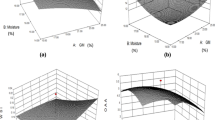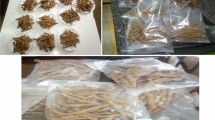Abstract
The low-amylose rice flour, seeded banana (Musa balbisiana, ABB) and carambola (Averrhoa carambola L.) pomace blends were extruded to prepare ready to eat breakfast cereal in a single-screw extruder. Response surface methodology using a central composite design was used to evaluate effect of independent variables, namely blend ratio (80:10:10 – 60:30:10 of low-amylose rice flour, seeded banana and carambola pomace), screw speed (200 – 400 rpm), barrel temperature (90 – 130 °C) and feed moisture content (9 – 21 g/100 g, wet basis) on product responses. Quadratic polynomial equations were also obtained by multiple regression analysis. The predicted models were adequate based on lack-of-fit test and coefficient of determination obtained. The feed moisture content had critical effect on all response variables. The compromised optimal conditions obtained by numerical integration for development of extrudates were: screw speed of 350 rpm, barrel temperature of 120 °C, feed moisture content of 12 g/100 g and 65:25:10 of blend ratio of feed. In the optimized condition low-amylose rice blend is found to have better physicochemical properties (water absorption index of 481.79 g/100 g; water solubility index of 44.13 g/100 g) and dietary fiber content of 21.35 g/100 g respectively. The developed breakfast cereal showed considerable amount of minerals (Mg and K) and overall acceptability was found to be 7.8.







Similar content being viewed by others
References
Altan A, McCarthy KL, Maskan M (2008a) Evaluation of snack foods from barley–tomato pomace blends by extrusion processing. J Food Eng 84:231–242
Altan A, McCarthy KL, Maskan M (2008b) Extrusion cooking of barley flour and process parameter optimization by using response surface methodology. J Sci Food Agric 88:1648–1659
AOAC (2000) Official methods of analysis, 17th edn. Association of Official Analytical Chemists, Washington, DC
Balasubramanian S, Borah A, Singh KK, Patil RT (2012) Effect of selected dehulled legume incorporation on functional and nutritional properties of protein enriched sorghum and wheat extrudates. J Food Sci Technol 49(5):572–579
Barthakur NN, Arnold NP (1990) Chemical evaluation of Musa 'Bhimkol' as a baby food. J Sci Food Agric 53(4):497–504
Bhatnagar S, Hanna MA (1995) Physical, Mechanical and Thermal Properties of Starch-Based Plastic Foams. Trans of the ASAE 38(2):567–571
Chau CF, Huang YL, Lee MH (2004) Insoluble fibre rich fractions derived from Averrhoa carambola: hypoglycemic effects determined by invitro methods. Lebensm-Wiss U Technol 37:331–335
Chinnaswamy R, Hanna MA (1988) Optimum extrusion-cooking conditions for maximu expansion of corn starch. J Food Sci 53:834–836
Dhingra D, Paul S (2005) Optimization of drying condition s of garlic slices. J Food Sci Technol 42:348–352
Ding Q, Ainsorth P, Tucker G, Marson H (2005) The effect of extrusion conditions on the physicochemical properties and sensory characteristics of rice-based snacks. J Food Eng 66:283–289
Ding Q, Ainsorth P, Tucker G, Marson H (2006) The effect of extrusion conditions on the functional and physical properties of wheat-based expanded snacks. J Food Eng 73:142–148
Eastman J, Orthoefer F, Solorio S (2001) Using extrusion to create breakfast cereal products. Cereal Foods World 46:468–471
Fletcher SI, Richmond P, Smith AC (1985) An experimental study of twin-screw extrusion cooking of maize grits. J Food Eng 4:291–231
Guha M, Ali SZ (2006) Extrusion cooking of rice: Effect of amylase content and barrel temperature on product profile. J Food Process Preserv 30:706–716
Guha M, Ali SZ, Bhattacharya S (1998) Effect of barrel temperature and screw speed on rapid viscoanalyser pasting behaviour of rice extrudate. Int J Food Sci Technol 33:259–266
ICC. (1995). Rapid pasting method using the Newport rapid visco analyser. ICC-Draft Standard No. 162, Int Assoc Cereal Sci and Technol
Ilo S, Liu Y, Berghofer E (1999) Extrusion cooking of rice flour and amaranth blends. Wiss Technol 32(2):79–88
Jin Z, Hsiehl F, Huff HE (1995) Effects of soy fiber, salt, sugar and screw speed on physical properties and microstructure of corn meal extrudate. J Cereal Sci 22:185–194
Liu Y, Hsieh F, Heymann H, Huff HE (2000) Effect of process conditions on the physical and sensory properties of extruded oatcorn puff. J Food Sci 65:1253–1259
Lue S, Hsiieh F, Huff HE (1991) Extrusion cooking of corn meal and sugar beet fiber: effects on expansion properties, starch gelatinization and dietary fiber content. Cereal Chem 68:227–234
Montgomery, D.C. (1984). In Design and analysis of experiments (2nd ed., pp. 445–474). New York: John, Wiley and Sons.
Onwulata CI, Konstance RP, Smith PW, Holsinger VH (2001) Co extrusion of dietary fiber and milk proteins in expanded corn products. Lebensm Wiss Technol 34:424–429
Parker JK, Hassell GM, Mottram DS, Guy RC (2000) Sensory and instrumental analyses of volatile generated during the extrusion cooking of oat flours. J Agri Food Chem 48:3497–3499
Prosky L, Asp N-G, Schweizer TF, DeVries JW, Furda I (1988) Determination of insoluble, soluble, and total dietary fibre in foods and food products. J Assoc Off Anal Chem 71:1017
Sacchetti G, Pittia P, Pinnavaia GG (2005) The effect of extrusion temperature and drying-tempering on both the kinetics of hydration and the textural changes in extruded ready-to-eat breakfast cereals during soaking in semi-skimmed milk. Int J Food Sci Technol 40:655–663
Shui GH, Leong LP (2004) Analysis of polyphenolic antioxidants in star fruit using liquid chromatography and mass spectrometry. J Chromatogr 1022:67–75
Singh N, Smith AC, Frame ND (1998) Effect of process variables and monoglycerides on extrusion of maize grits using two sizes of extruder. J Food Eng 35:91–109
Singh S, Gamlath S, Wakeling L (2007) Nutritional aspects of food extrusion: a review. Int J Food Sci Technol 42:916–925
Stat-Ease Inc (2000) Design expert user guide. The Stat-Ease Inc, USA
Suknark K, Phillips RD, Chinnan MS (1997) Physical properties of directly expanded extrudates formulated from partially defatted peanut flour and different types of starch. Food Res Int 30:515–583
Suksomboon A, Limroongreungrat K, Sangnark A, Thititumjariya K, Noomhorm A (2011) Effect of extrusion conditions on the physicochemical properties of a snack made from purple rice (Hom Nil) and soybean flour blend. Int J Food Sci Technol 46:201–208
Tang J, Ding XL (1994) Relationship between functional properties and macromolecular modifications of extruded corn starch. Cereal Chem 71:364–369
Upadhyaya A (2008) Optimization of carrot pomace powder incorporation on extruded product quality by response surface methodology. Ph.D. thesis, Mahatma Gandhi Chitrakoot Gramoday Vishwavidyalys, Satna, MP
Yagci S, Gogus F (2008) Response surface methodology for evaluation of physical and functional properties of exruded snack foods developed from food-by-products. J Food Eng 86:122–132
Yulini S, Torley PJ, D’Arcy B, Nicholson T, Bhandari B (2006) Effect of extrusion parameters on flavor retention, functional and physical properties of mixtures of starch and D-limonene encapsulated in milk protein. Int J Food Sci Technol 41:83–94
Acknowledgment
One of us is thankful to the Ministry of Food Processing Industries, New Delhi for grant of a Senior Research Fellowship.
Author information
Authors and Affiliations
Corresponding author
Rights and permissions
About this article
Cite this article
Borah, A., Lata Mahanta, C. & Kalita, D. Optimization of process parameters for extrusion cooking of low amylose rice flour blended with seeded banana and carambola pomace for development of minerals and fiber rich breakfast cereal. J Food Sci Technol 53, 221–232 (2016). https://doi.org/10.1007/s13197-015-1772-9
Revised:
Accepted:
Published:
Issue Date:
DOI: https://doi.org/10.1007/s13197-015-1772-9




